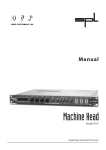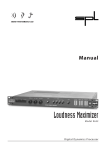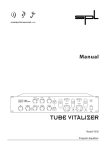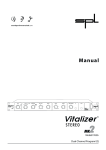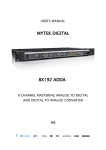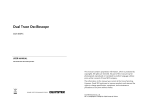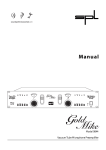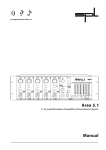Download Sound Performance Lab 9631 DJ Equipment User Manual
Transcript
Manual Spectralizer Model 9631 Digital Harmonics Processor SOUND PERFORMANCE LAB SPECTRALIZER MODEL 9631 Manual by Hermann Gier and Paul White Version 2.2 – 1/1999 The information in this document has been carefully verified and is assumed to be correct. However Sound Performance Laboratory (SPL) reserves the right to modify the product described in this manual at any time. Changes without notice. This document is the property of SPL and may not be copied or reproduced in any manner, in part or full without the authorization of SPL. Limitations of Liability: In no event will SPL be liable for any damages, including loss of data, lost profits, cost of cover or other special, incidental, consequential or indirect damages arising from the use of the unit, however caused and on any theory of liability. This limitation will apply even if SPL or an authorized dealer has been advised of the possibility of such damage. SPL electronics GmbH P.O. Box 12 27 D- 41368 Niederkruechten, Germany Phone: +49 - 21 63 / 9 83 40 Fax: +49 - 21 63 / 98 34 20 eMail: [email protected] www.spl-electronics.com © 1999 SPL electronics GmbH. All Rights Reserved. Foreword Thanks Introduction Operation Safety Connections, installing Updates Quick Start Flow Chart Control Elements ACTIVE INPUT GAIN FREQUENCY MIX 2ND HARMONIC 3RD HARMONIC DENSITY LC-DISPLAY SOLO KICK PRESETS INFO (Hardware dialogue) OUTPUT PPM Specifications Warranty 3 3 4 5 6 7 7 Contents 8 8 9 9 9 10 11 11 11 11 11 12 15 16 17 Dear customer, Thank you for the confidence you have shown towards SPL electronics GmbH by purchasing the SPL SPECTRALIZER. You have decided to use a tool of high performance which sets you in the position to have faster success and a better sound quality in your music productions and pre-masterings. Foreword As a typical SPL unit the SPECTRALIZER combines exemplary specifications and high manufacturing standard with excellent sound quality to provide you a precious component for studio and mastering purposes. Please read this manual carefully to ensure you have all the information you need to use the SPECTRALIZER. We wish you every success with the SPECTRALIZER. Your SOUND PERFORMANCE LAB-Team I would like to start with my thanks to all our staff, who created what is to be described here. Special thanks go to Jörg Houpert, Klaus-Peter Webersinke and Andreas Skäbe from Spectral Design, as well as Harald Obenland from Octum electronics. The importance of their exceptional qualification and talents cannot be overestimated. Thanks Our products are often tested and compared in many publications and by our customers themselfs and constantly valued with best results. I would like to pass on this broad appreciation to those, who deserve it – my excellent colleagues. Hermann Gier Spectralizer 3 Introduction Re-synthesizing second and third harmonics separately Improving clarity, intelligibility and depth without introducing harshness Warm and smooth sounding harmonic re-synthesis SPL digital audio processors are designed in cooperation with Spectral Design of Bremen, Germany, who are responsible for the DSP programming. Concept: The SPECTRALIZER is the first digital harmonics processor employing a new process which allows you to re-synthesize second and third harmonics separately, and with full control over their amplitude. The SPECTRALIZER benefits from SPL's expertise in psycho-acoustic principles and is the ideal tool to improve the clarity, transparency and intelligibility of any signal in the digital domain. A single instrument or vocal gains better penetration within a mix, while complete mixes benefit from improved subjective loudness without a measurable change in levels. While developing the DSP-program, a strong emphasis was placed on achieving warm and smooth sounding harmonic resynthesis. The digital domain tends to be susceptible to “sharpness” at the HF end of the spectrum, which made the design of the SPECTRALIZER all the more demanding. The result is a tool able to increase brightness and detail without adding harshness or sounding fatiguing. In comparison to ostensibly similar analogue systems, the SPECTRALIZER does not produce any phase deterioration, nor introduce unmusical intermodulation products. Easy and intuitive operation Operation: The SPECTRALIZER is fitted with six encoder controls, and the actual parameters values are shown in the LCD window. INPUT GAIN sets the overall input level with gain adjustment available from -20 dB to +6 dB, while the starting frequency for the re-synthesis of the harmonics is set using the FREQUENCY control. This functions as a high-pass filter adjustable over the range 1kHz to 7 kHz in 500 Hz steps; signals with a frequency lower than that selected using the FREQUENCY control remain unaffected. The DENSITY control offers a choice of six settings to determine the amplitude envelope of the added harmonics and works rather like a digital compressor to increase the density of the re-synthesized harmonics – which makes them more prominent. The 2ND and 3RD HARMONIC controls set the relative levels of the re-synthesized harmonics while the MIX control defines the balance between the new harmonics and the original signal. The SPECTRALIZER has three switch functions: SOLO mutes the original input signal so that the added harmonics can be heard in isolation while KICK adds a greater proportion of harmonics to transients (attack parts of the signal). The ACTIVE button switches the SPECTRALIZER in and out of operation; when connected via AES/EBU, a relay-operated hard bypass switches the digital input directly to the output. Signal flow remains uninterrupted, even if the mains power is switched off. The software bypass function compensates for the inevitable (but very short!), digital domain processing delay so as to avoid 4 Spectralizer the small timing glitches that would otherwise occur when switching the process in and out. Up to 99 presets can be stored and changed using a MIDI program change command. Display: The SPECTRALIZER is equipped with two PPM-meters that feature high resolution in the important region immediately before 0dB. Clip-LEDs indicate digital clipping, while the first LED of each PPM-meter functions as a signal present indicator to confirm that a digital signal is present at the input. The philosophy behind the digital audio processors is that they are designed to be operated like analogue units; there is only one INFO menu but no multi-function controls. The LCD readout simply shows the current encoder positions and the preset number. The encoders are built without clicks or detents, so they feel like analogue pots. Our DSP platform uses two Motorola 56002 DSPs running at 66 MHz. This enormous computational power guarantees real-time operation where sophisticated DSP algorithms will not be restricted by resource limitations. The general concept is that each digital processor should fulfill only one task, in the most effective way possible, and with a minimum of controls and switches. As much as possible should be automated to promote user-friendly operation – the external controls access only the sonically relevant parameters. Additionally all controls with a wide value range (e.g. 0 to 100) are programmed with an 'alpha-dial' logic. Turning the encoder rapidly causes the values to jump in steps of 10, whereas turning the encoder slowly causes the values to proceed in single increment steps. The housing of the SPECTRALIZER has the standard 19"- EIA format and occupies 1U (44 mm) in your rack. When installing the unit in a 19"-rack, the rear side of the unit needs some support, especially in a touring case. Input and Output PPM metering “Analogue“ control feeling The DSP Platform: Enormous computational power guaranteeing realtime operation User-friendly programmed software Operation Safety The SPECTRALIZER should not be installed near units which produce strong magnetic fields or extreme heat. Do not install theSPECTRALIZER directly above or below power amplifiers. Check that the voltage details quoted on the back panel are the same as your local mains electricity supply. Use a minus (-) screwdriver to set the voltage selector to the voltage for the area in which the unit will be used. Never cover up the ventilation slots on the top of the unit. If, during operation, the sound is interrupted or indicators no longer illuminate, or if abnormal odor or smoke is detected, or if liquids are spilled on the unit, immediately disconnect the power cord plug and contact your dealer. Only clean your SPECTRALIZER with a soft, lint-free cloth. Spectralizer 5 Connections Before connecting the SPECTRALIZER switch the power off at all connected units. The rear panel provides AES/EBU- and S/P-DIF-inputs and outputs. Any additional channel, status and user-bits are passed through unaltered, and the outputs can be used at the same time if required. The SPECTRALIZER operates with 24 bit word width. It accepts 16 bit and 20 bit inputs and will create output signals according to the input resolution. For synchronisation purposes WORDCLOCK IN and WORDCLOCK THROUGH BNC connectors are fitted with a switchable 75 Ohm termination. MIDI IN and MIDI THROUGH connectors allow presets to be selected via MIDI program change commands. For easy upgrade of future software releases, the rear panel offers RS-232 interface for PC and RS-422 interface for MAC. Installing Updates: Note: All presets will be lost after installing a new software version! 1. Connect your computer with the SPECTRALIZER via a serial port with a standard Z-modem cable. RS-232 for PC and RS-422 for MAC. 2. Open a terminal program like “Hyperterminal” on PC and make the following adjustments: Baud rate: 9600; Stop bit: 1; Parity: none; Data bit: 8; Handshake: no; Transfer mode: ZMODEM Rear Panel Spectralizer 6 3. Switch on the SPECTRALIZER and depress both PRESET UP and PRESET DOWN until the LC-display says “wait for Zmodem download“. 4. Load the update file into your terminal program and send it to the SPECTRALIZER. The LC-display shows the progress of the download in kB. 5. After successfully installing the new software version the LC-display says “download valid”. 6. Switch the SPECTRALIZER off and on. The new software version number is displayed in the first INFO page (simultaneously depress STORE and APPLY; also refer to CONTROL ELEMENTS No. 9, INFO). 7. If an error occurred during download the LC-display says “download failed”. The SPECTRALIZER now waits for a new download. Please check all adjustments on your terminal program and try again. If you are still unsuccessful contact your local dealer. Spectralizer Set all controls to the starting positions: INPUT GAIN 0; FREQUENCY 1k; DENSITY 0; 2ND HARMONIC 0%; 3RD HARMONIC 0%; MIX 0%. 1. Depress ACTIVE. The status-LED illuminates. 2. Set MIX to 50%. You will notice an increase in high frequencies above 1 kHz (starting position FREQUENCY). 3. Set DENSITY to 1, to increase the audibility of the harmonics in the next step. 4. Set 2ND HARMONIC to 50% and 3RD HARMONIC to 30%. 5. If you are using full scale material for this initial test drive the CLIP LEDs may illuminate. Reduce the INPUT GAIN to give additional headroom for the new harmonics. 6. To compare original and processed signal press ACTIVE. The status LED goes out. Quick-Start Use the SOLO button to monitor the added harmonics precisely. Flow Chart Input Encoder Effect Original FrequencyEncoder HighpassFilter Diagram 1: Signalflow Spectralizer Generator 2nd Harmonic Encoder Kick- Density- Encoder Encoder Generator 3rd Harmonic Encoder SoloTaste MixEncoder Spectralizer 7 Control Elements 8 9 10 2 3 Active 7 1 INPUT GAIN = 0 for processing pre-production material with enough headroom Choose negative INPUT GAIN values for full scale recordings to create new headroom to add harmonics Use positive INPUT GAIN values for low level material 8 6 4 1 13 12 The ACTIVE function switches the SPECTRALIZER on or off. The illuminated LED indicates that the processing is activated. The software bypass also compensates for the 5 ms time delay between processed and unprocessed signal. Relay hard-bypass for AES/EBU input and output Input Gain 5 11 The AES/EBU input and output are equipped with relayhard-bypass. In the event of a power failure the SPECTRALIZER is automatically switched to hard-bypass (power failure safety) without interrupting the data flow. 2 INPUT GAIN controls the input level of the digital source. You can boost the input gain by up to +6 dB or attenuate it by up to -20 dB. The LC-display (see 8) shows the actual value. Adjustment: If you are about to process pre-production material which has not yet been normalized nor limited, you should set the INPUT GAIN to 0 dB. If your source material has already been mastered and limited it is advisable to adjust negative values for the INPUT GAIN control in order to create new headroom for the processing. Keep in mind that the SPECTRALIZER adds new harmonics to the source material. If the source is a full scale recording the added harmonics will immediately create an overload indicated by the illuminating CLIP LEDs. If your source material has a very low level you can use the SPECTRALIZER´S INPUT GAIN control to boost the level without making changes to the sound. Additionally you drive the SPECTRALIZER into an operational level to work properly. Spectralizer 3 Frequency MIX controls the mix level between the processed and the unprocessed signal. The control range is 0 % to 100 %. The MIX encoder is equipped with an „alpha-dial“ logic. Turning the encoder rapidly causes the values to jump in steps of 10, whereas turning the encoder slowly causes the values to proceed in single increment steps. 4 Mix 5 2nd Harmonic Control Elements FREQUENCY sets the starting frequency of the highpass filter. Above this frequency second and third harmonics are being generated. The highpass filter can be varied between 1 kHz and 7 kHz in steps of 500 Hz. Example: All controls are set to the starting position: INPUT GAIN 0; FREQUENCY 1k; DENSITY 0; 2ND HARMONIC 0%; 3RD HARMONIC 0%; MIX 0%. Turn the MIX to 50%. You will hear an increase in high frequencies above 1 kHz due to the starting position of the FREQUENCY control. Until now you have not yet added any harmonics. The increase in high frequencies is a boost of all frequencies above 1 kHz. You can change the starting frequency by turning the FREQUENCY encoder clockwise to higher frequencies. For some applications this may already do the job. To add harmonics set 2ND HARMONIC to 50% and 3RD HARMONIC to 30%. If the audible effect is very subtle increase the DENSITY setting to 1 or 2 (details see DENSITY, 7). The 2ND HARMONIC encoder controls the intensity of the added second harmonics which are being generated above the adjusted highpass frequency (see FREQUENCY, 3). The second harmonics are even harmonics which bring a soft and silky top-end to the sound. In comparison to odd harmonics, even harmonics do not contain as much brightness and they also do sound softer. Diagram 2: 2ND HARMONIC The illustration shows the FFT spectrums of the even harmonics for a measuring signal of 3 kHz. Spectralizer 9 Control Elements The control range is 0 % to 100 %. The 2ND HARMONIC encoder is equipped with alpha-dial logic. Turning the encoder rapidly causes the values to jump in steps of 10, whereas turning the encoder slowly causes the values to proceed in single increment steps. If the need arises to make the harmonics more audible use the DENSITY control (see DENSITY, 7) to increase their loudness. 3rd Harmonic 6 The 3RD HARMONIC encoder controls the intensity of the added third harmonics which are being generated above the adjusted highpass frequency (see FREQUENCY, 3). The third harmonics are odd harmonics which carry brilliance but also sharpness and aggressiveness. A good combination of even and odd harmonics is the key to a natural sounding topend. The control range is 0 % to 100 %. The 3RD HARMONIC encoder is equipped with alpha-dial logic. Turning the encoder rapidly causes the values to jump in steps of 10, whereas turning the encoder slowly causes the values to proceed in single increment steps. If the need arises to make the harmonics more audible use the DENSITY control (see DENSITY, 7) to increase their loudness. Diagram 3: 3RD HARMONIC The illustration shows the FFT spectrums of the odd harmonics for a measuring signal of 3 kHz. Diagram 4: If two frequencies are fed into the Spectralizer (here 3 and 4 kHz) also the differential tone (here 7 kHz) are being produced All measurements at: 1kHz FREQUENCY 0 DENSITY 100% MIX 10 Spectralizer DENSITY increases the loudness of the generated harmonics by applying different “compression ratios”. The control offers six positions. Density 8 LC-display The SOLO function switches the original input off. You will hear the effect signal only to be able to monitor the highpass-filtering and harmonics generation. 9 Solo The KICK function boosts the amplitude of the generated harmonics in the event of creation (attack-period). After that the amplitude drops back to its original value. KICK should be used when you want to apply additional “sparkle” and presence to the signal. 10 Kick The SPECTRALIZER allows you to store up to 99 presets, which can be changed by MIDI program change command. 11 Preset Control Elements 7 Adjustment: If DENSITY is set to 0, the generated harmonics have low intensity even at high values for 2ND and 3RD HARMONIC. The increase in high frequencies is mostly created by the highpass filtering, which applies a shelving equalizing above the adjusted FREQUENCY encoder (see FREQUENCY, 3). Increasing DENSITY to 1 or 2 will increase audibility of the generated harmonics. High DENSITY values (4 to 6) may lead to audible distortion depending on the source material. Use the SOLO function (see 9) to hear the harmonics in isolation. The LC-display shows all encoder settings. More information is displayed when activating the INFO pages (see 9). Press STORE and APPLY for one second to enter the INFO pages. If you want to store a new adjustment, depress STORE for one second. The LED starts to flash indicating that the STORE mode has been activated. The LC-display now shows the actual preset number. Use UP and DOWN to select a new preset location. The status-LED flashes shortly to indicate that the input (depressing UP or DOWN) is accepted. Keeping UP or DOWN depressed will let you jump through the preset list in steps of 5 presets. Once a new preset location is found depress STORE again. The STORE LED goes out. The preset is stored at the new location. In case you want to quit the STORE mode without storing the new adjustments simply press APPLY. Spectralizer Storing a preset: Depress STORE for1 sec., LED flashes; use UP/DOWN to select preset no.; depress STORE again, LED goes out 11 Control Elements Applying a preset: Depress APPLY for1 sec., LED flashes; use UP/DOWN to select preset no.; depress APPLY again, LED goes out If you want to apply various presets depress APPLY for one second. The APPLY LED starts to flash indicating that the APPLY mode is activated. You can step through the preset list with UP and DOWN. Once you have a preset that you want to apply depress APPLY again. The APPLY LED goes out indicating that the preset is applied. Operation safety: Presets can not be changed by accident To increase operation safety it is impossible to apply presets by simply depressing UP or DOWN. The UP and DOWN statusLEDs will not flash indicating that the input is not accepted. You have to depress STORE or APPLY for one second in order to activate the UP and DOWN buttons. Info In case you want to quit the APPLY mode without applying the new preset simply press STORE. 12 Depressing STORE and APPLY simultanouesly for about one second gets you into a hardware dialogue, called INFO. The LCdisplay shows status informations of the digital data stream. With UP/DOWN you will jump from one page to the next or previous. If a selection is provided use APPLY to select. 1. Software version and date 2. Selecting inputs: The SPECTRALIZER automatically searches for an input signal. If both inputs are connected the AES/EBU input will be selected first. If you want to select the S/P-DIF input you have to call up the INFO pages. AES/EBU input detected or: no AES/EBU input detected Press APPLY (if AES/EBU is detected): AES/EBU input with wordclock detected 12 Spectralizer AES/EBU input without wordclock is detected Press APPLY : S/P-DIF input detected Control Elements or: or: no S/P-DIF input detected Press APPLY (if S/P-DIF is detected): S/P-DIF with wordclock detected or: S/P-DIF input without wordclock is detected 3. Displaying the detected sample frequency: The SAMPLE FREQUENCY will be detected automatically. The display either shows 44,1 kHz, 48 kHz or 32 kHz. 4. Displaying the Audio-Error flag: NO = no error detected; YES = error detected 5. Displaying the CRC-Error flag: NO = no error detected; YES = error detected Spectralizer 13 Control Elements 6. Displaying the Channel Difference Error flag: NO = no error detected; YES = error detected 7. Setting or erasing the Copy-Prohibit flag: NO = flag erased or not set; YES = flag set 8. Displaying the Original flag: NO = no Original flag; YES = Original 9. Displaying the Emphasis flag: NO = no emphasis; YES = with emphasis 10. Selecting a serial port: RS-232 interface for update-download from PCs or (press APPLY): RS-422 interface for update-download from MACs. 11. Selecting a MIDI channel: Depress APPLY to step from MIDI CHANNEL 01 up to MIDI CHANNEL 16. 14 Spectralizer In order to increase operation safety only send the necessary MIDI data to the SPECTRALIZER. Unnecessary information might lead to system failure. You can use MIDI to create a MIDI fade out, if you are working with a digital console that does not provide master inserts. The UP and DOWN LEDS illuminate indicating that a volume change command is received. You can also switch between presets with the MIDI program change command. This can especially be useful, when you are mastering a song, for example, that requires different settings for chorus, refrain, or bridge. The APPLY LED illuminates indicating that a program change command is received. MIDI IMPLEMENTATIONS Function Received Data Note Basic Channel: Change 1-16 stored Control Change: 7 1-127 Volume 0-99 real value Program Change: You leave the INFO-pages by depressing STORE. The OUTPUT LED chains are PPM (peak level) meters with signal and clip indicators. The metering offers 1 dB resoltion for the last 3 dB before 0 dB. 13 Output PPM The first LED in the OUTPUT PPM meter is a signal (SIG.) LED to indicate that a valid digital source is connected and detected. This LED helps you to verify the signal flow within a digital processing chain. If one SIG. LED is not illuminating you have a first indication of a faulty digital signal flow. The last LED of the OUTPUT PPM meter is a CLIP LED. The LED illuminates if the digital signal is too hot causing digital distortion. Spectralizer 15 Specifications Input/Output Sample rate frequency, autom. 32-48kHz AES/EBU, twisted pair (1) AES/EBU in- & output impedance AES 3 110 Ohms S/P-DIF, co-axial (2) S/P-DIF input impedance SPDIF-2 75 Ohms Wordclock In/Through, co-axial Wordclock in-/output impedance BNC 75 Ohms MIDI In/Through yes RS 232 RS 422 (max +/- 14 V) yes yes Clip display yes Input transformer (AES/EBU) Output transformer (AES/EBU) Relay Hard Bypass (AES/EBU) yes yes yes Measurements AES/EBU: Jitter S/P-DIF: Jitter Wordclock In: Jitter 1ns 3ns 1,5ns Power supply Torroidal transformer Fuse GND-Lift switch Voltage selector 60 VA 1A/slow blow yes 115V/230V Dimensions 19"/1U 482 x 44 x 350mm Weight 4,9 kg (1) AES/EBU is defined for levels from 2 V to 7 V Measurements AES/EBU: 4,4 V with load (2) S/P-DIF is defined for levels from 200 mV to 700 mV Measurements S/P-DIF: 500 mV with load Subject to change without notice. 16 Spectralizer SPL electronics GmbH (hereafter called SPL) products are warranted only in the country where purchased, through the authorized SPL distributor in that country, against defects in material or workmanship. The specific period of this limited warranty shall be that which is described to the original retail purchaser by the authorized SPL dealer or distributor at the time of purchase. Warranty SPL does not, however, warrant its products against any and all defects: 1) arising out of materials or workmanship not provided or furnished by SPL, or 2) resulting from abnormal use of the product or use in violation of instructions, or 3) in products repaired or serviced by other than authorized SPL repair facilities, or 4) in products with removed or defaced serial numbers, or 5) in components or parts or products expressly warranted by another manufacturer. SPL agrees, through the applicable authorized distributor, to repair or replace defects covered by this limited warranty with parts or products of original or improved design, at its option in each respect, if the defective product is shipped prior to the end of the warranty period to the designated authorized SPL warranty repair facility in the country where purchased, or to the SPL factory in Germany, in the original packaging or a replacement supplied by SPL, with all transportation costs and full insurance paid each way by the purchaser or owner. All remedies and the measure of damages are limited to the above services. It is possible that economic loss or injury to person or property may result from the failure of the product; however, even if SPL has been advised of this possibility, this limited warranty does not cover any such consequential or incidental damages. Some states or countries do not allow the limitations or exclusion of incidental or consequential damages, so the above limitation may not apply to you. Any and all warranties, express or implied, arising by law, course of dealing, course of performance, usage of trade, or otherwise, including but not limited to implied warranties of merchantability and fitness for particular, are limited to a period of 1 (one) year from either the date of manufacture. Some states or countries do not allow limitations on how long an implied warranty lasts, so the above limitations may not apply to you. This limited warranty gives you specific legal rights, and you may also have other rights which vary from state to state, country to country. SPL electronics GmbH 41372 Niederkrüchten, Germany Spectralizer 17

















